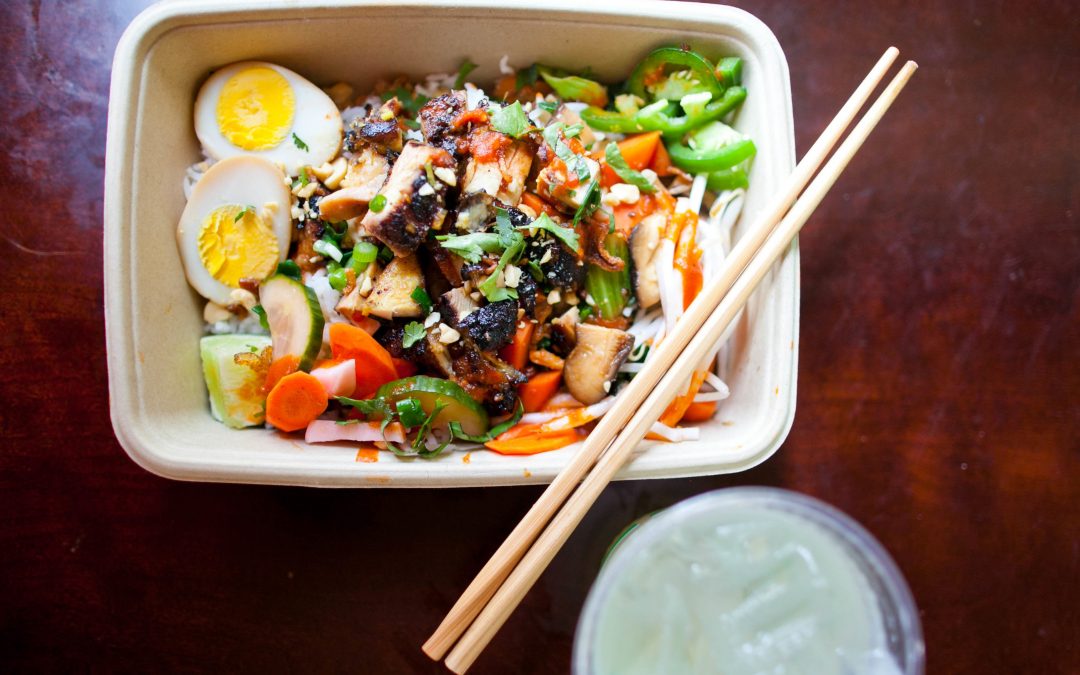By Nicholas Upton
We’ve all been there. You order delivery or carryout and eagerly open the bag to find not the beautiful restaurant presentation, but a soggy mess. If you’re on the receiving end, you don’t want a soggy mess, but even more important, no restaurant worth its salt wants to deliver a soggy mess.
Presentation matters and with the multitude of delivery options today, consumers are less willing to trade it for convenience.
Frank Klein, founder and CEO of Asian Box, a five-unit Bay Area-based concept focused on Asian street foods, shared some of his brand’s journey to the ideal packaging. His search started long before the restaurant opened, and as a sustainable-lifestyle concept, his ideal packaging had to be as environmentally friendly as possible.
“We have trademarked the term, ‘What’s in your box,’” said Klein. “So the box is very important to our whole overall concept.” (They also tout their food is from “farm to box.”)
The initial research introduced Klein and the brand to a fully compostable box from packaging supplier Sabert; which offers several lines of compostable or recyclable foodservice packages.
Aside from a move to a recyclable lid to stop leaks and display the food better, that package has remained the same. But as delivery started picking up in the heart of third-party delivery world, Klein said they had to change things up.
“We had to morph into a package that would travel better,” said Klein, who reported between 10 and 15 percent of orders were through an exclusive partnership with DoorDash. Therefore, the first step toward a new delivery package was with that partner.
“We talked to DoorDash about how the delivery with the food is going, then we tried to poll some of their consumers about the packaging,” said Klein. “Their team is very good at making sure the quality of the food is maintained, in that there are constant talks about packaging and bags and utensils and things of that nature.”
After collecting data about what was important to delivery customers, Klein tested a few packages to see how they held up with the food. He had a few important things top-of-mind.
“We wanted to see retention of moisture, no bleed through, no discoloration of food, no discoloration of the packaging. That’s very important. If you put food in a package like Chinese food that is all soggy and leaking through, that’s not a good representation of your product,” said Klein.
Other factors tested were keeping hot foods hot, cold foods cold and crispy foods crispy. It’s a different journey for every brand, but given that most packaging vendors sell nationally, every restaurant can find that Goldilocks delivery package.
Ultimately, Klein decided on something that was all but ubiquitous for delivery, but was still sustainable, durable and checked all the boxes for the traveling metrics he set forth.
“For to-go and delivery, we’re using the most sustainable product on the planet, which is aluminum, so basically we’re using a small catering tent that’s highly recyclable with a compostable cardboard lid that’s easy to write on, so we save on packaging stickers and all that stuff that we need to put the person’s name on the box,” said Klein.
For others following in his footprint, Klein said be sure to ask vendors how long your item will be in stock. Packaging vendors test plenty of products as well, so he advised ensuring the packaging will be around indefinitely before investing in an operational change.
And then there’s the cost. Great packaging isn’t cheap, so restaurants need to get in tune with delivery demographics and what makes sense since they’re not likely to pay much more via third-party delivery (or the restaurant is barred by the services to charge more). Klein said, “most brands would not stomach what we pay per box,” but to keep his environmentally and presentation-conscious demographics, it’s worth the cost because ultimately that box is part of the restaurant experience.
“Packaging is important to the brand and customers that align with that brand,” said Klein. “The standard black-plastic Chinese to-go box just wouldn’t work.”


